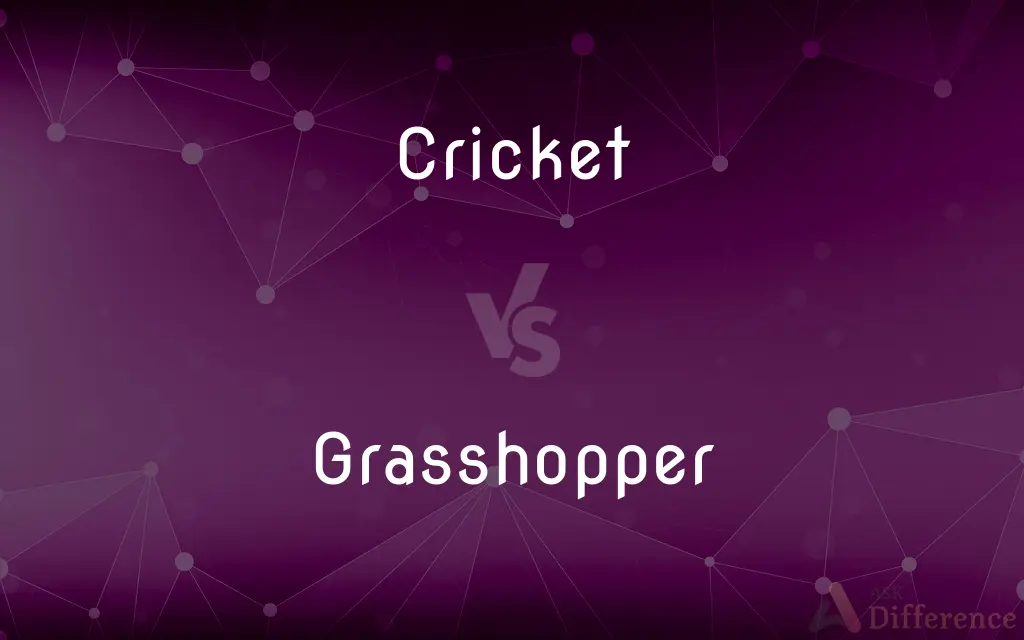Cricket vs. Grasshopper — What's the Difference?
By Tayyaba Rehman & Maham Liaqat — Updated on March 25, 2024
Cricket is known for its chirping sound, produced by males, while grasshoppers make noise by rubbing their legs against wings.

Difference Between Cricket and Grasshopper
Table of Contents
ADVERTISEMENT
Key Differences
Crickets are nocturnal insects famous for their distinctive chirping sounds, primarily made by males as a call to females. This sound is produced by rubbing their wings together, a behavior known as stridulation. On the other hand, grasshoppers are generally diurnal, more active during the day, and produce sounds by rubbing their hind legs against their wings, a process called crepitation. This difference in behavior and sound production mechanism highlights the varied ways these insects communicate.
Crickets often have a more rounded body shape and tend to be darker in color, varying from brown to black, which aids in their nocturnal activities by providing camouflage in the dark. Grasshoppers, however, usually have a more elongated body and come in shades of green, brown, or yellow, which helps them blend into grassy environments during the day.
The diet of crickets is omnivorous, allowing them to consume both plant material and small insects, giving them a versatile approach to sourcing food. Grasshoppers are predominantly herbivorous, feeding mainly on leaves, which influences their habitat preferences and impacts agricultural areas more significantly due to their potential for crop damage.
Crickets are found in a variety of habitats, including forests, fields, caves, and even within urban areas, showing a great adaptability. Grasshoppers prefer open grasslands and fields where they can easily find food and bask in the sun, indicating a more specific preference for habitat.
The lifecycle of crickets usually involves incomplete metamorphosis, meaning they develop through a series of nymph stages without a distinct pupal stage. Grasshoppers also undergo incomplete metamorphosis, but they tend to have more defined and visually distinct stages of growth, making their development easier to observe.
ADVERTISEMENT
Comparison Chart
Sound Production
By rubbing wings together (stridulation)
By rubbing hind legs against wings (crepitation)
Activity Time
Nocturnal
Diurnal
Body Shape and Color
Rounded, darker colors (brown to black)
Elongated, lighter colors (green, brown, yellow)
Diet
Omnivorous (plants and small insects)
Herbivorous (primarily leaves)
Habitat
Varied (forests, fields, urban areas)
Open grasslands and fields
Compare with Definitions
Cricket
Crickets exhibit incomplete metamorphosis.
Cricket nymphs resemble adults but are smaller and lack wings.
Grasshopper
Prefer open habitats.
Grasshoppers thrive in fields and grasslands.
Cricket
Crickets are nocturnal insects recognized for their chirping.
The sound of crickets at night is often considered a symbol of quiet rural life.
Grasshopper
They produce sound through crepitation.
The grasshopper's song is made by its legs rubbing against its wings.
Cricket
They have a versatile diet.
Crickets can eat both plant materials and small insects.
Grasshopper
Grasshoppers undergo incomplete metamorphosis.
As they grow, grasshopper nymphs gradually develop wings.
Cricket
Crickets use stridulation to produce sounds.
The cricket's chirp is created by the rubbing of its wings.
Grasshopper
Grasshoppers are known for their jumping ability.
Grasshoppers use their powerful hind legs to leap great distances.
Cricket
Their habitat is diverse.
Crickets can be found in both forests and urban gardens.
Grasshopper
Their diet is mainly herbivorous.
Grasshoppers can cause damage to crops due to their feeding habits.
Cricket
Any of various orthopteran insects of the family Gryllidae, having long antennae and legs adapted for leaping. The males of many species produce a shrill chirping sound by rubbing the front wings together.
Grasshopper
Grasshoppers are a group of insects belonging to the suborder Caelifera. They are among what is probably the most ancient living group of chewing herbivorous insects, dating back to the early Triassic around 250 million years ago.
Cricket
An insect in the order Orthoptera, especially family Gryllidae, that makes a chirping sound by rubbing its wing casings against combs on its hind legs.
Grasshopper
Any of numerous orthopteran insects, chiefly of the suborder Caelifera, characteristically having long, powerful hind legs adapted for jumping.
Cricket
An orthopterous insect of the genus Gryllus, and allied genera. The males make chirping, musical notes by rubbing together the basal parts of the veins of the front wings.
Grasshopper
A light, usually unarmed airplane used for liaison and scouting.
Cricket
Leaping insect; male makes chirping noises by rubbing the forewings together
Grasshopper
A cocktail consisting of crème de menthe, crème de cacao, and cream.
Grasshopper
A mostly herbivorous insect of the order Orthoptera, noted for its ability to jump long distances and for the habit of some species communicating by stridulation; they are related to but distinct from crickets.
Grasshopper
In the strict sense, refers to insects in the suborder Caelifera, particularly those in the family Acrididae.
Grasshopper
In a looser sense, also includes the katydids (also known as longhorned grasshoppers or bush crickets), which are members of the family Tettigoniidae, of the suborder Ensifera.
Grasshopper
A cocktail made with crème de menthe and optionally with crème de cacao.
Grasshopper
(figuratively) A young student in initial stages of training who has been chosen on account of their obvious talent.
Grasshopper
(musical instrument) In ordinary square or upright pianos of London make, the escapement lever or jack, so made that it can be taken out and replaced with the key.
Grasshopper
Any jumping, orthopterous insect, of the families Acrididæ and Locustidæ, having large hind legs adapted for leaping, and chewing mouth parts. The species and genera are very numerous and some are very destructive to crops. The former family includes the Western grasshopper or locust (Caloptenus spretus), noted for the great extent of its ravages in the region beyond the Mississippi. In the Eastern United States the red-legged (Caloptenus femurrubrum and C. atlanis) are closely related species, but their ravages are less important. They are closely related to the migratory locusts of the Old World. See Locust.
Grasshopper
In ordinary square or upright pianos of London make, the escapement lever or jack, so made that it can be taken out and replaced with the key; - called also the hopper.
Grasshopper
An antipersonnel mine that jumps from the ground to body height when activated, and explodes, hurling metal fragments over a wide area.
Grasshopper
A mixed alcoholic beverage containing crème de menthe, light cream, and sometimes crème de cacao. The name comes from its light green color.
Grasshopper
Terrestrial plant-eating insect with hind legs adapted for leaping
Grasshopper
A cocktail made of creme de menthe and cream (sometimes with creme de cacao)
Common Curiosities
What colors are crickets and grasshoppers typically?
Crickets are often darker (brown to black), whereas grasshoppers are lighter (green, brown, yellow).
What are the main differences in sound production between crickets and grasshoppers?
Crickets produce sound by rubbing their wings together, while grasshoppers do so by rubbing their hind legs against their wings.
Are crickets nocturnal or diurnal?
Crickets are primarily nocturnal.
What do crickets eat?
Crickets have an omnivorous diet, including plant material and small insects.
What is the preferred habitat of grasshoppers?
Grasshoppers prefer open grasslands and fields.
Do crickets cause as much crop damage as grasshoppers?
Grasshoppers are more likely to cause significant crop damage due to their herbivorous diet.
How do grasshoppers affect agriculture?
Due to their diet, grasshoppers can significantly impact agriculture by feeding on crops.
What time of day are grasshoppers most active?
Grasshoppers are most active during the day (diurnal).
How do crickets and grasshoppers produce their sounds?
Crickets use stridulation, and grasshoppers use crepitation.
Can crickets be found in urban areas?
Yes, crickets can adapt to urban environments.
How do crickets and grasshoppers differ in their development stages?
Both undergo incomplete metamorphosis but differ in their nymph stages' appearance and development.
What kind of environments do crickets prefer?
Crickets are versatile and can live in various environments, from forests to urban settings.
Do both crickets and grasshoppers have wings?
Yes, both insects have wings, but they use them differently, notably in sound production.
Are grasshoppers or crickets better adapted for jumping?
Grasshoppers are especially known for their powerful jumping abilities.
Is the cricket's diet more varied than the grasshopper's?
Yes, crickets have an omnivorous diet, making their food sources more varied.
Share Your Discovery

Previous Comparison
Atom vs. Molecule
Next Comparison
Throw vs. DropAuthor Spotlight
Written by
Tayyaba RehmanTayyaba Rehman is a distinguished writer, currently serving as a primary contributor to askdifference.com. As a researcher in semantics and etymology, Tayyaba's passion for the complexity of languages and their distinctions has found a perfect home on the platform. Tayyaba delves into the intricacies of language, distinguishing between commonly confused words and phrases, thereby providing clarity for readers worldwide.
Co-written by
Maham Liaqat















































